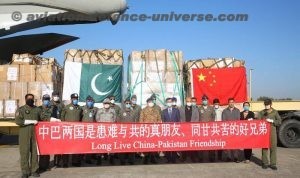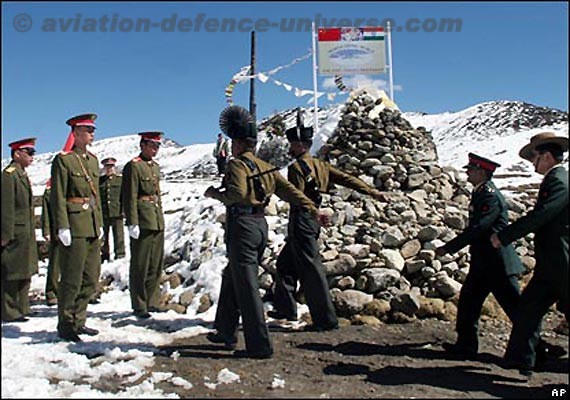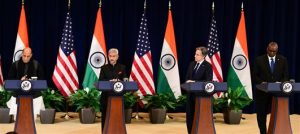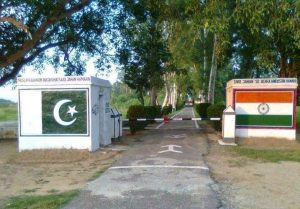By Lt Gen Abhay Krishna (Retd)
New Delhi. 26 January 2023. Talking about a Two-Front War scenario in India’s context, it seems a different ball game altogether, because India does not project herself as a potential aggressor. The use of expression ‘Two-Front War,’ has gradually turned into a military terminology essentially to summarise the combined threat on the Nation from both the Western and Northern fronts. Both Army and Air Force Chiefs, past and present, have been heard on a number of occasions reassuring the Nation through various media interactions that India is always prepared to fight a Two-Front War. This repeated assurance definitely indicates availability of adequate resources and preparedness to take the battle into the adversary’s territory.
During the Indo-Pak war of 1971, India definitely fought on two fronts; but it was with a common adversary on both the fronts. Does the currently propagated concept of a Two-Front War mean fighting simultaneously on two specific fronts that is Western and Northern Fronts or fighting Two Different Adversaries? The former involves two specific geographical segments while the latter may involve more than two directions or geographical regions.

Understanding the Terminology
Going back in time, one famous example of a Two-Front War in recent military history of the world, is that of the aggressor Germany that chose to open two fronts simultaneously and later, faced the consequences of spreading its forces to both East and West. For any aggressor, it is always wise to concentrate his forces on one front and take on his enemies one by one. In military terminology, therefore, a Two-Front War is one in which fighting takes place on two geographically separate fronts. It is usually executed by two or more separate forces simultaneously or nearly simultaneously, in the hope that their opponent will be forced to split his fighting force to deal with threats on both the fronts
However, talking about a Two-Front War scenario in India’s context, it seems a different ball game altogether, because India does not project herself as a potential aggressor. India always talks of defending her territorial integrity instead. A Two-Front War in respect of India will involve a combination of both China and Pakistan. But who out of the two will then start the war or will it be both and that too simultaneously? Let us examine and find the answer.
Though China’s military is being taken as a force to reckon with at the global level due to their reforms, modernisation and technological developments, the fact is that China has not fought any war post 1979.
India China BorderHow Battle Hardened is China
China had set out to teach India a lesson in 1962, but it is commonly believed that China could not achieve its objective. Rather, it landed up doing a favour to India by compelling the nation to shed the self-imposed restrictions and instead, embark on rebuilding its military power. Also, the 1962 conflict not only buried the charmed concept of “Hindi-Chini Bhai–Bhai” for good; but also fuelled an enduring enmity and lack of trust between the two countries.
It will be interesting to note that though today, China’s military is being taken as a force to reckon with at the global level due to their reforms, modernisation and technological developments, the fact is that China has not fought any war post 1979.
The People’s Republic of China and the Socialist Republic of Vietnam had fought a war in early 1979. China had launched an offensive in response to Vietnam’s actions against the Khmer Rouge in 1978. The war lasted for 27 days and finally, after suffering losses, China withdrew. Though China claimed victory in this war, but the fact was that Vietnamese occupation of Cambodia continued until 1989. Interestingly, Chinese military had other failures too prior to 1979, where they suffered and withdrew without achieving any objective. Besides the war in Vietnam, China suffered defeat during the Chinese-North Korean invasion of South Korea in 1950-53, Nathula clash of 1967 and Sino-Soviet border conflict of 1969 over the Zhenbao Island.
However, China has a few instances of victory to boast about such as taking over of Tibet and successfully crushing the uprising in 1959, China-Burma border campaign where they succeeded in evicting Kuomintang in 1961 as also successfully established control over Paracel Islands of South Vietnam in 1974.
Post the 1962 war, as far as the Line of Actual Control (LAC) with India is concerned, differences in perception with regard to ownership over few geographical segments of the terrain along the LAC continues to linger which has often resulted into friction along the border. In the recent past, Doklam followed by Ladakh were the latest cases which turned into major standoff between the two Armies. Unlike the Line of Control (LOC) with Pakistan which perpetually burns, as far as the LAC with China is concerned, the last bullet was fired in 1973.

Conflict with Pakistan
India and Pakistan have fought several wars since August 1947. Soon after independence, the Indian Army had to move into Kashmir on the request of its ruler Maharaja Hari Singh when Pakistan had managed to successfully push across the border close to Srinagar, a large number of armed tribesmen duly supported by the Pakistan Army. Fierce encounters took place and the Indian Army managed to push the Pakistani forces back beyond a line when the ceasefire was signed in 1949 which later on was accepted as the LOC. As a result of the ceasefire, the remaining area of Kashmir known as Pakistan Occupied Kashmir (POK), could not be freed from Pakistani control.
The second war took place in 1965 when Pakistani soldiers once again attempted to cross over into Kashmir to ignite insurgency. It was a miscalculation on the part of Pakistan that India was militarily unprepared having suffered at the hands of Chinese in the 1962 war.
The third full scale war was fought in December 1971 when civil unrest had taken deep roots in East Pakistan seeking independence. India was badly affected as the entire region was thrown into turmoil with massive influx of refugees. India was left with no choice but to intervene militarily. Then came another intrusion attempt by Pakistan in Siachen, resulting in the Kargil conflict in 1999, which of course remained localised and did not escalate into a full-scale war for various reasons.
Apart from these military actions between the two countries since independence, there have also been a number of provocative flash points which could have resulted into a major conflict. India has faced a number of major Pakistan-sponsored terrorist attacks on non-military establishments such as the attack on the Indian Parliament in December 2001, blast in Samjhauta Express in February 2007, attack on Taj Hotel Mumbai in November 2008 and the suicide car bombing in Pulwama in February 2019 that killed 40 CRPF personnel. Apart from these flash points, terrorism in Kashmir Valley, terrorist attacks on military targets and frequent actions on the LOC continue as always. India claimed Aksai Chin as part of Ladakh, for China, it was always an integral part of Tibet.
Long Term Strategic Gain
In the 1962 conflict, if China wanted, they could have retained captured territory up to Tawang which has a tremendous religious sentiment attached with Tibet. Had they done this, then under the circumstances prevailing those days it would have been well-nigh impossible for India to retake Tawang. But strangely, China did not do so despite the much-publicised dispute related to their claim over Arunachal Pradesh being part of Southern Tibet. They took a unilateral decision to withdraw completely, but on the other side, they decided to retain over 2000sq km of alpine desert in Ladakh which was totally uninhabited with no resources. This was taken as an insignificant gain for China at that time, but the importance was realised only later when it connected Tibet and Xinjiang, or to say Lhasa with Kashgar, giving them the most strategic advantage, they were looking for to set course in not so a distant future. Though India claimed Aksai Chin as part of Ladakh, for China, it was always an integral part of Tibet. China later ceded over 750 sq km of territory to Pakistan and in return, Pakistan recognised Chinese sovereignty on 800 sq km of territory in Northern Kashmir and Ladakh. The 1962 war with India,thus resulted in a major strategic gain for China. Since then, the claim of ownership of Arunachal Pradesh by China, apparently has been only a “Drum to Beat” once a while for distracting or attracting attention depending on the prevailing situation, circumstances and motive.
Instances of International Support
As far as India is concerned, the 1962 War was a big jolt which led to the reversal of defence policy. However, the silver lining was that the three major powers of the world namely the United States (US), the Soviet Union and the United Kingdom came out openly in support of India recognising the McMahon Line as the international border between India and China.
While both the US and the Soviet Union diplomatically intervened during the 1965 Indo-Pak War and managed to cease the conflict, the situation was different during the conflict in 1971. Major support came from the Soviet Union when they moved their nuclear warships and submarines to counter the US Navy’s Seventh Fleet which was moving into the Indian Ocean to support Pakistan. India had already entered into a twenty-year deal with the Soviet Union prior to the 1971 War stating that any attack on India would be taken as attack on the Soviet Union. Then came the Kargil conflict during which Israel came in support of India making readily available several modern weapon systems for both the Indian Air Force (IAF) and the Indian Army.
Interestingly, in every conflict with Pakistan, other than providing economic aid and political support, China has always avoided military involvement. But how long will this continue in the times ahead? Today, besides supplying military equipment to Pakistan, the Chinese military is also present inside Pakistan to protect the China-Pakistan Economic Corridor (CPEC). Considering China’s global aspirations, under the prevailing circumstances, China may not prefer to get involved in a war with India especially as an aggressor.
China’s Own Compulsions
China has been investing heavily in military modernisation and reportedly enjoys technical superiority in some areas such as anti-ship missiles, cyber and space capabilities which also is a threat for the US. China has successfully developed Anti Access Area Denial system which will help keep the US forces away from their coast. China has built military bases including airports on the islands in the South China Sea. China also has an ambient presence in the Indian Ocean Region from the Strait of Hormuz to the Strait of Malacca. With gradual shift of focus from the Middle East, the US has started to look more at the Asia-Pacific Region considering China as a long-term threat. The South China Sea and Taiwan are therefore a matter of concern for China.
With China’s huge irreversible investment in the CPEC passing through the disputed territories of Aksai Chin, POK and finally turning Gwadar port into a Container Port. The possibility of it turning this port into a base for the Chinese Navy in the future cannot be ruled out. China already has a military base in Djibouti. Besides the slowing economy, China is also vulnerable to ongoing simmering unrest in Tibet and Xinjiang province. This vulnerability can be exploited by the Western powers. This is why China does not want to annoy the terrorist organisations in Pakistan that are capable of cross-border terrorism and provide support to Uyghur Muslims in Xinjiang.
Considering China’s global aspirations, under the prevailing circumstances, China may not prefer to get involved in a war with India especially as an aggressor. A war with India will not only inflict a heavy dent on their economy pushing it behind by many years compared to other powers of the world especially the US, but will also provide an opportunity to the US to take strategic advantage in the South China Sea and Taiwan further strengthening Quadrilateral Security Dialogue (QUAD) and other alliances in the Asia-Pacific Region as a front against China. Though India is not a part of any military alliance, the Nation has very close relationship with major countries including Russia, the US, Israel, France and close neighbours such as Bangladesh, Bhutan, Nepal and Sri Lanka, serving and safeguarding each other’s indispensable mutual interests. Thus, a direct attack by China on India, will not only invite the US fleet into the Asia-Pacific Region, but will also enlarge the conflict spectrum attracting other allies of the US and India too.
Pakistan – A Conundrum
Apart from the compelling fixation on Kashmir, more for ensuring their own survival as a country than anything else, Pakistan has also been harbouring a desire for long to pursue Ghazwa-e-Hind to establish an Islamic Caliphate in India. Any attempt by Pakistan to achieve this objective, is likely to be supported by the Arab countries.
Pakistan is a poverty-stricken country reduced to total bankruptcy with insurmountable fiscal deficit. Internal strife in Baluchistan, Khyber Pakhtunwa, Gilgit Baltistan and Sindh is getting out of control and so is the increasing societal and ethnic divide. The public image of the Pakistan Army has also hit a new low where radicalisation is believed to have sipped in. They are now being seen as a parasite on national resources and incapable of defending the country anymore.
The Real Emerging Threat Domain
In a Two-Front War scenario that India is looking at, will Pakistan be the main aggressor and China the covert supporter exploiting the strategic opportunity to contain India from growing economically and militarily into a nation strong enough to be able to tilt the balance of power extending from the Indian Ocean to the Asia-Pacific Region as per own choosing? Today, under the prevailing global security scenario, neither Pakistan nor China are actually in a position to be the main aggressor against India.
However, notwithstanding the prevailing situation in Pakistan, just in case this nation chooses a suicidal option to wage a war against India on the pretext of saving their persecuted Muslim brethren in Kashmir playing the victim card and indirectly enhancing the credit of their own Army in the eyes of countrymen as well as garner support from the International Community especially the Muslim World to save their country from breaking down, then will China join overtly or covertly? In such a scenario, China will not only deploy its ground forces close to the LAC posing as a potential threat in the offing essentially to tie down India’s dual-tasked formation from moving out, but will also enhance the uninterrupted military supply and other administrative support to Pakistan. Will China stop at this?
Apart from developing long range attack capability by a credible array of missiles, China has moved far ahead in the domain of non-contact warfare to include electronic, cyber and space domains. It is believed that the main culprit behind a cyber campaign targeting US utility companies in July 2019 was the notorious Chinese state-sponsored hacking group APT10.
The cyber-attack on Mersk Company in Ukraine, one the largest shipping company in the world, had successfully shut their entire IT infrastructure and had brought activity at the ports to a grinding halt for three days, is one of the best examples of Non-Contact Warfare being deployed during war by state backed actors. Are we prepared today to foil such a cyber-attack by China on our Railway Network, Banking System, Medical emergency services and Power Grid? Do we have adequate safeguards against China’s space warfare capability to take down Indian satellites which will directly affect the operational capability of Indian Navy?
Are we, therefore, actually ready to fight the so called Two-Front War in ‘Multi-domain of today’s prevailing hi- tech era’? India also needs to consider establishing military bases in critical locations such as Djibouti, Japan and in locations close to Southern China.
India’s Choice to Real Threat
When India claims to be fully prepared for a ‘Two-Front War’, it implies that the Nation is well prepared to engage the adversaries not only in multi-domains, but on multiple fronts as well. The possibility of China posturing along the Northern Front and simultaneously unleashing multiple domains retaining deniability for its actions, facilitating Pakistan in any military action initiated by it, appears a more controlled action with prevailing geopolitics. Then, where does the much talked about “credible deterrence” and “rebalancing of forces” fit in? War is never fought and won on mathematical calculation and theoretical equation of forces. As such, India must prioritise capability building in multiple domains.
As the war with Pakistan and China will not be restricted only to Western and Northern Fronts and will instead spread across the entire spectrum, India should seriously consider developing three-dimensional manoeuvre capability with missiles striking up to Pearl River Delta Harbour. The Indian Ocean and the Indo-Pacific Region will turn into a hot bed. The Indian Ocean Region is a major global seaborne trading route for China. The time has, therefore, now come to commence building expeditionary forces and provide more teeth to both the Indian Navy and the IAF. India also needs to establish military bases in critical locations such as Djibouti, Japan and in locations close to Southern China. India, at the same time, must continue with strong economic linkages with China, but on own terms, and at the same time, work towards rebuilding strong military alliance with the traditional friend Russia.
As Future Looks
History of India is replete with stories of repeated invasions that did not remain confined to land routes only. India always failed to check the invaders who came across the oceans be it the Dutch, the Portuguese or the British. With the kind of technological development that has taken place and the race to ensure trade and energy security by world powers to ensure dominance, India’s war with Pakistan and China in the future will not remain confined to Western and Northern geographical fronts only, but instead it will spread to multi domain opening up number of fronts for India to tackle.

Somehow, over a period of time, as a consequence of repeated assurance given of being prepared to fight a Two-Front War and referring to raising of mountain corps, creating Integrated Battle Groups, border development, creating dual tasked formations, rebalancing of forces etc, the Two-Front War scenario somehow, started to appear confined only to two specific geographical regions and directions.
Under the given circumstances of the kind of threat developing against India through multi-domains in not too distant a future as also the necessity of developing capability and wherewithal to tackle the enemy on multiple fronts, India may have to consider, apart from tri-service integration and theaterisation, handing over the operational charge of all three services to the Chief of Defence Staff in order to ensure better coordination and optimum utilisation of all military resources under a single umbrella of command and control .
(Lt Gen Abhay Krishna, PVSM, UYSM, AVSM, SM, VSM (Retd) former Army Commander of South Western, Eastern and Central Army Commands, Indian Army , commissioned into Rajputana Rifles. The General Officer also held the position of the Chief Commissioner, West Bengal Right to Public Services Commission. The views in the article are solely the author’s. He can be contacted at editor.adu@gmail.com).




























































































































